SATURDAY – WEDNESDAY 9 AM – 1 PM & 5 PM – 10 PM
FRIDAY 5 PM – 10 PM
THURSDAY – Weekly Off
SATURDAY – WEDNESDAY 9 AM – 1 PM & 5 PM – 10 PM
FRIDAY 5 PM – 10 PM
THURSDAY – Weekly Off
Kids love us. Parents trust us!
Your child’s smile is precious, so you should do everything you can to make sure it stays healthy and beautiful. Rousso Medical Center is a friendly and caring expert providing excellent pediatric dentistry services for younger patients. To learn more about pediatric dentistry, call the offices or use the online booking tool to schedule a visit.
What is pediatric dentistry?
Pediatric dentistry is dental care geared specifically to younger patients. The team of caring professionals at Rousso Medical Center offers exceptional pediatric dentistry and are highly skilled at optimizing oral health for their younger.

Temporary Teeth Have Permanent Implications-Baby teeth may not last forever, but they do have a lasting impact. Strong baby teeth make learning to speak and crunching on nutritious foods easier, and a healthy smile boosts confidence. Baby teeth also act as placeholders for permanent teeth, so any disruption to these temporary teeth that goes untreated can cause serious problems later.
Pediatric Dentistry Treatment Options:
Treatment of uncooperative/pre-cooperative children, with uncontrollable body movements, can be unsafe in a dental treatment room. There are several options available to help manage your child during dental treatment. Each option has risks and benefits. The information below will help you understand the advantages/disadvantages and the limitations to the various treatment options we offer. Our doctors and staff will discuss all treatment options with you and make recommendations as to what is the best modality to treat your child while keeping them safe and comfortable.
No Treatment:
No treatment can be a reasonable alternative; however, oral infections or disease can lead to hospitalization and can be life threatening.
Local Anesthesia (Sleepy Juice) Only:
Local anesthesia is often required to restore (place a filling) or extract (remove /wiggle) a tooth. This technique involves injecting a numbing anesthetic (lidocaine) via a small needle into the gum tissue near the tooth that needs to be fixed. This treatment option works well for the very cooperative child that doesn’t mind getting an injection. For younger children who are afraid of needles, this option should be used in conjunction with nitrous oxide and/or oral conscious sedation. Young children are often unpredictable and can become restless and fearful without warning. For a variety of reasons, some children may become frightened (ie. noise from the dental drill (tooth whistle) or from the strange sensation of their numb tooth, teeth or tongue). For this reason, we recommend at least nitrous oxide’ and in some instances conscious oral sedation, for children under 5 who require local anesthesia to fix their teeth.
Nitrous Oxide Sedation (Laughing Gas) and Local Anesthesia (Sleepy Juice):
This type of sedation is effective with children who may have slight anxiety but are willing to have the treatment performed. It is effective for children who have limited work that needs to be done. Children with more extensive treatment needs will require multiple visits or oral sedation. Nitrous oxide is used on most often on children who have good behavior, and have treatment that can be done in a half hour or less. This gas is most helpful with minor fillings and surgeries for slightly anxious children age 4 and older. Children who are uncooperative/pre-cooperative or who are unwilling to follow instructions (e.g., breath through your nose) etc. this technique will not be successful.
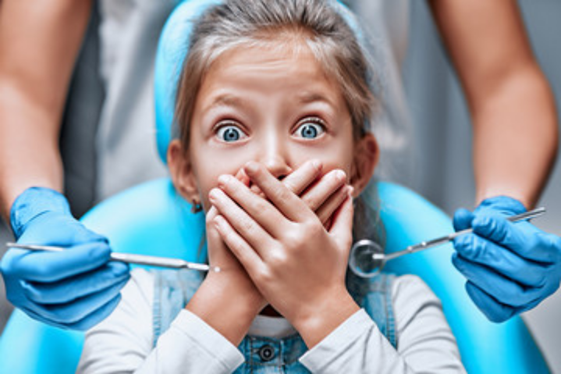
Nitrous Oxide is a very safe sedative gas inhaled by your child while wearing a mask on their nose (like a clown nose). The maximum relaxing effect is reached by breathing the sweet-smelling air through their nose. It is important that your child understands that throughout the procedure, they will need to breath through their nose and avoid mouth breathing. After breathing the gas, your child typically feels relaxed and less anxious. Nitrous oxide DOES NOT put your child to sleep. At the end of the procedure, we will turn off the nitrous oxide and place our child on oxygen only. Once your child is on 100% oxygen, they will have no residual effects from the nitrous oxide gas. Nitrous oxide is one of the safest drugs that we have in anesthesia and dentistry.
Conscious Oral Sedation (with Nitrous Oxide and Local Anesthesia) `:
This is not “sleep dentistry”. We do not believe in this technique or in using “deep sedation” with children. We use oral conscious sedation to help facilitate your child’s treatment and your child will be awake. Oral sedation is commonly used with children over 3 years of age who require the use of local anesthesia and whose treatment requires greater than 30 minutes of treatment time. Sedation patients may require two visits to complete their dental treatment. Our goal is to help your child relax and to ‘take the edge off’ so they don’t mind being in the dental treatment room. Children with severe asthma are not candidates for conscious oral sedation.
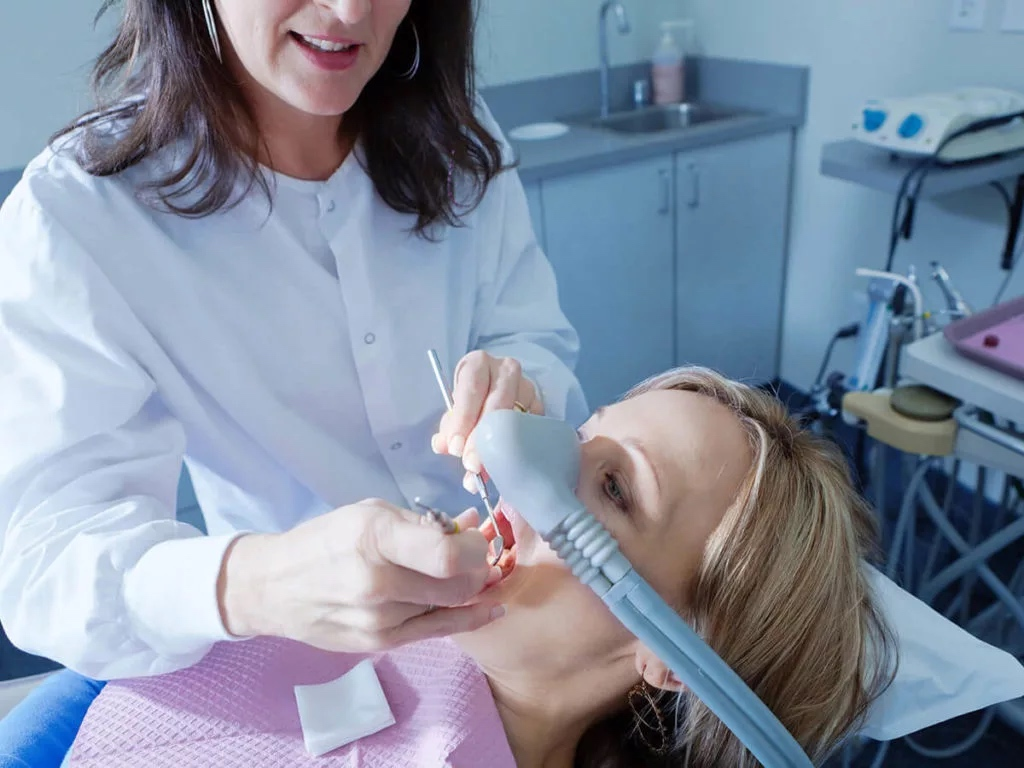
Your child is not to eat or drink anything after midnight the night before their appointment. If your child is sick, or sounds congested, we may reschedule their sedation; your child’s safety is our greatest concern. This sedative requires that your child sip the fruit-flavored medicine from a cup. We flavor the medication to improve the taste. After drinking the medication, you will wait with your child in our sedation waiting area, where you may read to your child or watch a movie with them. Once sedated, we will treat your child with great care and respect.
Some children may fall asleep during the dental treatment; however, the majority will be awake or partially awake. Occasionally, a child may cry or resist treatment during the procedure. Sometimes the sedative will not be effective and we may recommend that your child be treated with general anesthesia.
After the sedation, your child is not to go back to school; rather, they should remain home for the remainder of the day. They will need to have an adult with them to monitor them with appropriate supervision. Because our sedation is very mild, it may seem that your child is not sedated anymore. However, we recommend that your child engage in quiet, indoor play at home, and that they have limited physical activity.

General Anesthesia
All of your child’s dental treatment can be completed in one visit under general anesthesia in an operating room at a hospital. Your child is completely asleep and unaware of any treatment being performed. This is the same technique used to remove a child’s tonsils. General Anesthesia is sometimes necessary for children that are unable, by either age or maturity level, to cooperate during dental treatment. This is a wonderful option for an infant, a very anxious child, children who require major dental treatment, children with strong gag reflexes, children who have had negative dental experiences, children who have sound or smell aversions and children who are medically compromised or have special needs. Children treated with general anesthesia must have a recent physical examination by a pediatrician and meet with the anesthesiologist prior to their treatment at the hospital. Most medical and dental insurances cover a portion of these fees; however, pre-authorization is often required.
Stainless Steel Crowns (SSCs)
Stainless steel crowns are used to restore back teeth that are too badly decayed to hold white fillings. When tooth decay on back teeth has been left untreated, teeth may have extensive damage to the enamel, dentin and sometimes the nerve (pulp). In such cases, tooth-colored fillings are not a viable option, and stainless-steel crowns necessary. These prefabricated silver-colored crowns are fit; then cemented onto the primary (baby) teeth to prevent further damage until these teeth are naturally lost.
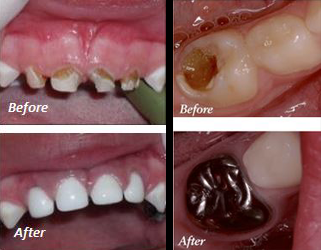
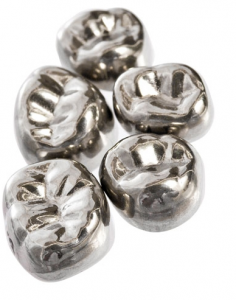
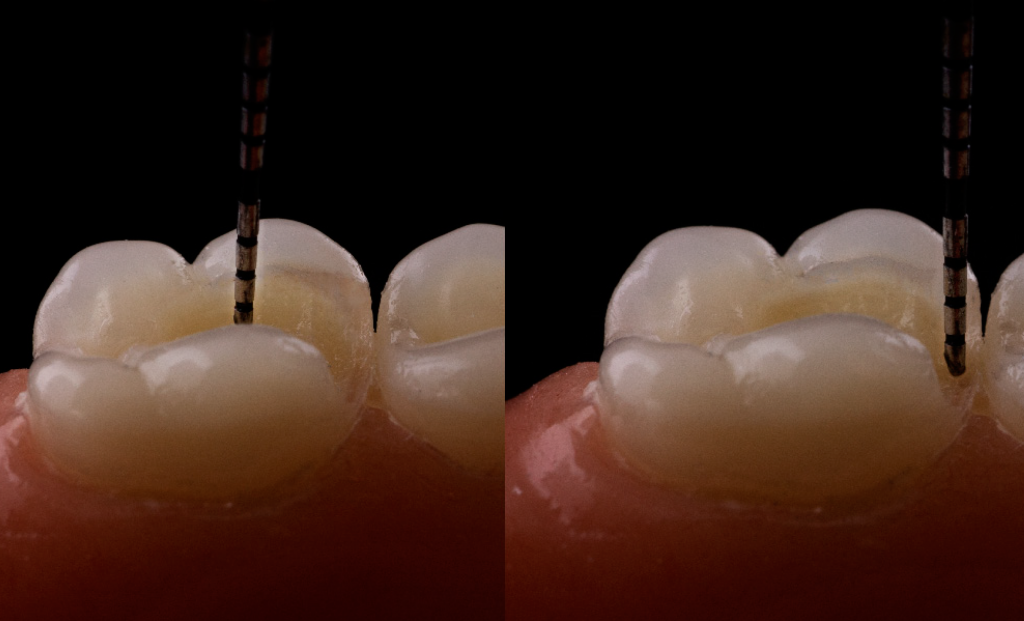
Tooth colored fillings are used to restore front or back teeth or where cosmetic appearance is important. Composites are used to repair fractured teeth and/or areas of decay. The shade of the composite restorative material is matched as closely as possible to the color of the natural teeth.
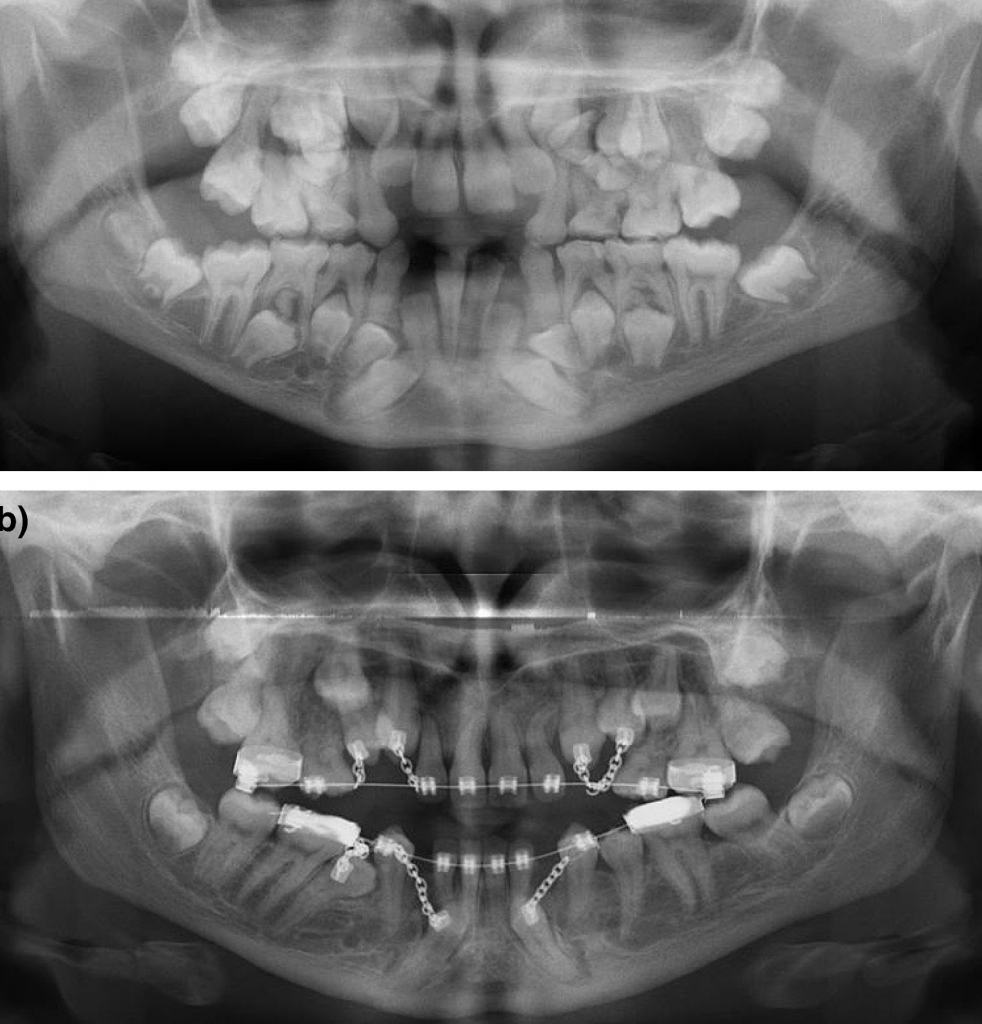
In general, children need X-rays more often than adults. Their mouths grow and change rapidly. X-rays can often show weaknesses in the tooth structure (such as demineralization) that may not be visible with the naked eye. The American Academy of Pediatric Dentistry recommends X-ray examinations every six months for children with a high risk of tooth decay. Children with a low risk of tooth decay require X-rays less frequently. We use digital radiography which uses approximately 1/4 the radiation of the traditional dental x-rays.
Dental Cleaning (Prophylaxis)
During a dental visit, the dental assistant or hygienist will first review your child’s medical history with you. This is to ensure the update of on the general health of your child so that we may review any factors that may concern your child’s dental health. Then your child’s mouth will be examined for overall oral health. Next, your child’s teeth will be thoroughly cleaned to remove plaque and calculus (hard tarter deposits), which can cause cavities and gum disease. After the cleaning, fluoride will be applied to the teeth to help protect and strengthen the weak areas against decay. For a healthy child, the American Academy of Pediatric Dentistry recommends a visit to the pediatric dentist at least every six months to evaluate your child’s oral health and development. However, if your child has special needs or is more predisposed to dental caries, the dentist may recommend more frequent visits to more closely manage your child’s oral health.
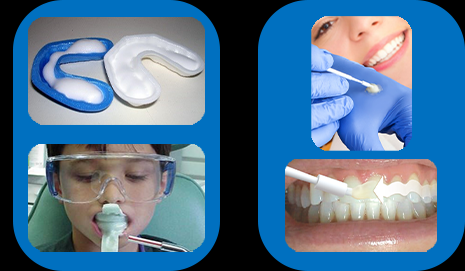
Fluoride
Cavities form when there is a weakening in the mineral composition of the enamel of your teeth. Fluoride promotes the remineralization of these decalcified spots, therefore helping to prevent cavities. We will monitor the development of your child’s teeth in order to prescribe the specific amount of fluoride that your child may need. In general, there is a careful balance between too much fluoride and too little fluoride. An excess of fluoride may damage developing teeth leading to fluorosis; while a deficit of fluoride leaves your child’s teeth susceptible to tooth decay.
Cavities (Caries)
Tooth decay (caries) is a progressive disease that often begins in very young children. Bacteria that normally live in the mouth react with sugars from foods and drinks to create acid that slowly eats away at the enamel of your child’s teeth and can also damage sensitive gum tissue. With the loss of enamel, weak points in the teeth form. These weak areas become cavities– which left alone can lead to irreversible nerve damage and the necessary early extraction of your child’s tooth.
Again, early treatment is the key. As soon as a cavity is identified, your pediatric dentist can repair the tooth using tooth-colored fillings. If the cavity is too deep, a pulpotomy nerve treatment and stainless-steel crown or extraction of the tooth may be needed. Effective brushing and flossing, the proper use of fluoride, and a balanced diet can help minimize the amount of decay to help your child have a happy, cavity-free smile!
Early (Interceptive) Orthodontic Care
It’s never too early to keep an eye on your child’s oral development. We can identify malocclusion (crowded or crooked teeth) or bite problems and actively intervene to guide the teeth as they emerge in the mouth. Interceptive orthodontic treatment can prevent more extensive treatment later. We check the progress of your child’s bite and jaw development with routine dental examinations. This early assessment of your child’s teeth may prevent extensive orthodontic work in his/her future.
Extractions (Tooth Removal)
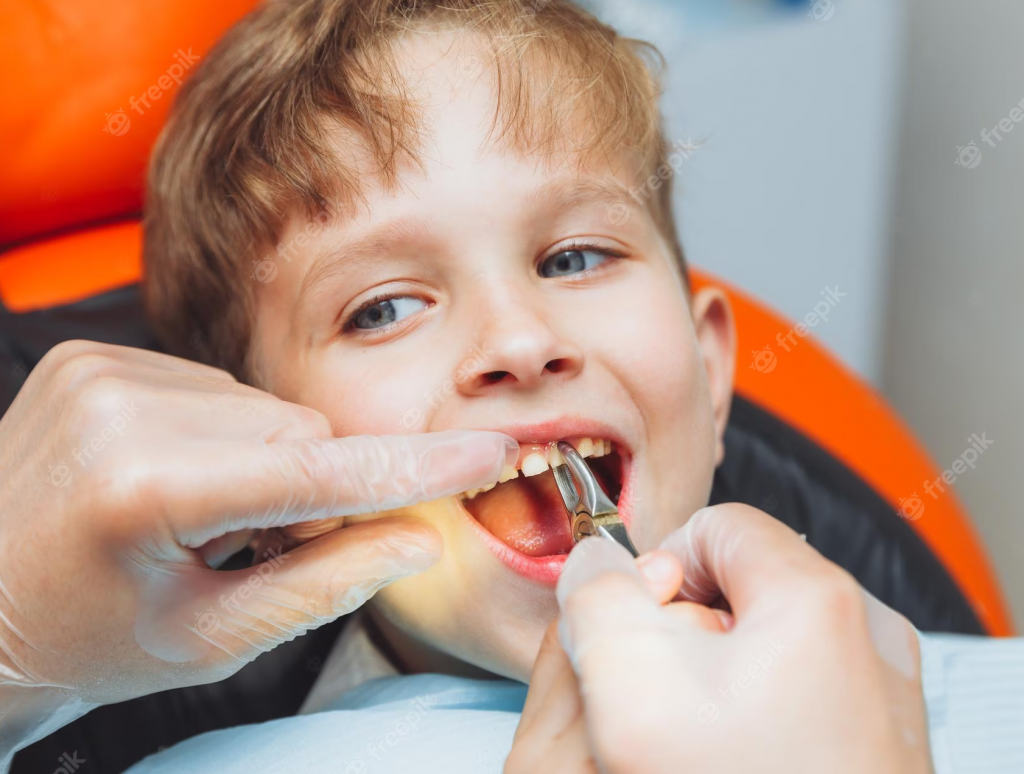
Extractions are done only as a last resort in the case of severe tooth decay. If a primary molar is removed prematurely, a space maintainer will be placed. Some extractions are needed for orthodontic reasons to help facilitate tooth alignment when crowded teeth are present. Primary teeth are essential in maintaining the correct spacing in your child’s jaw for the permanent teeth.
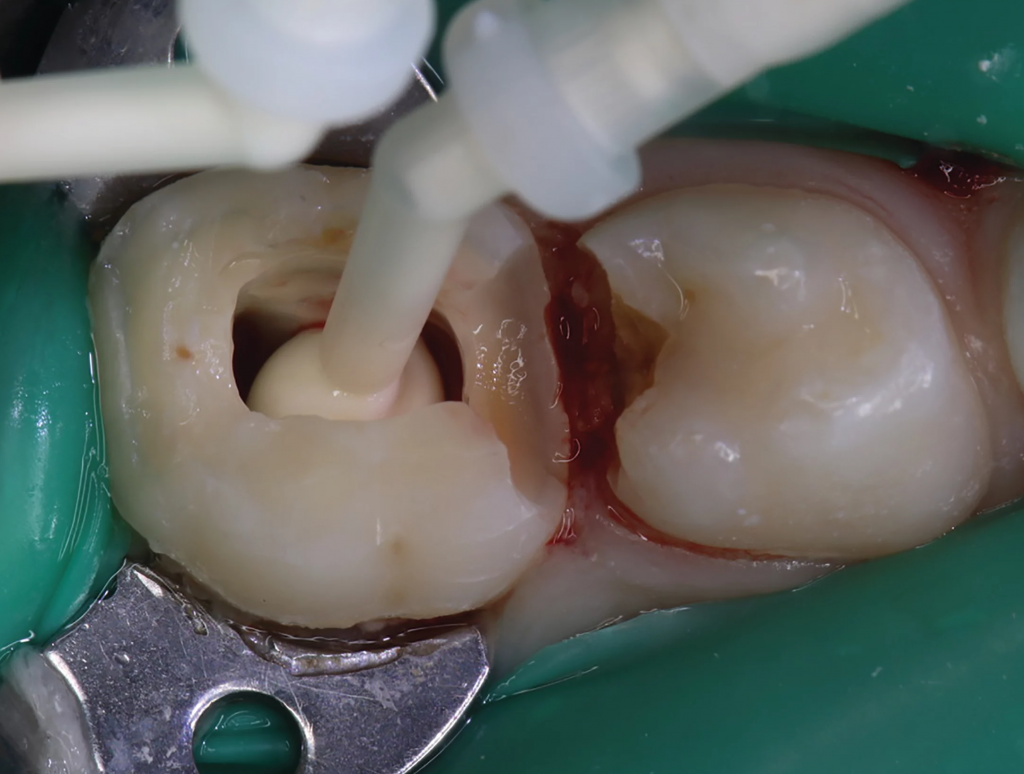
Pulp Treatment (Pulpotomy)
The purpose of a pulpotomy is to extend the life of the baby tooth, thereby avoiding the need for extraction and a space maintainer, until the eruption of the permanent tooth. Pulp therapy (pulpotomy) is the treatment of infected nerves and blood vessels in primary teeth. Pulp therapy generally becomes necessary for two reasons: either as a result of extensive tooth decay (dental cavities) or as the result of tooth injury. Failure to provide the necessary pulp therapy could result in your child experiencing pain, infection, swelling, or loss of the tooth.
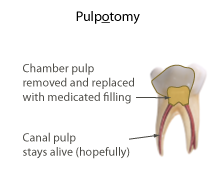
Sealants
Sealants are thin, white plastic coatings that are applied to the tops or chewing surfaces of back teeth and are highly effective in preventing tooth decay. The naturally occurring pits and grooves on the chewing surfaces of teeth can often collect plaque. These small grooves and cracks are the most susceptible to cavities in children and teens and benefit the least from topical fluoride. Sealants and fluoride work together to help prevent tooth decay. On average, sealants last for 5 to 10 years with proper maintenance. At every dental check-up, the dentist will check that the sealants are intact. In order to prolong the life of your child’s sealants, avoid crunchy foods and avoid chewing on ice and hard candy
Space Maintainers
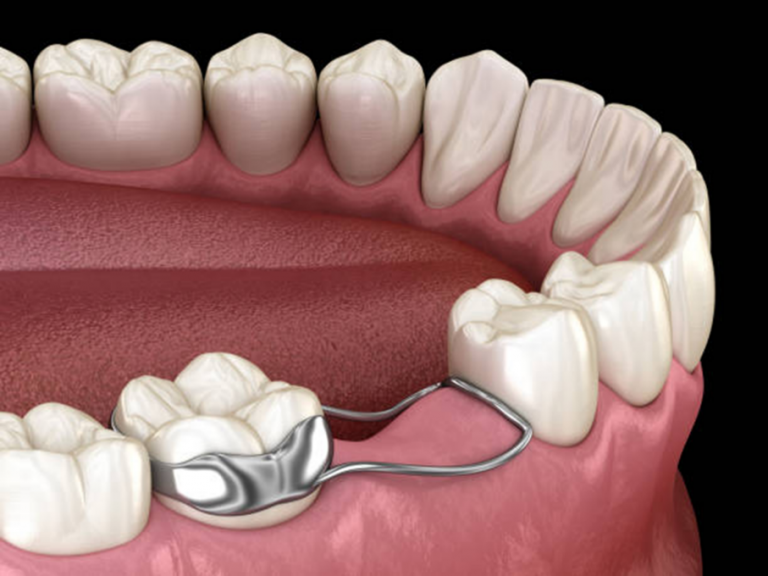
Space maintainers are used when a primary tooth has been prematurely lost (or extracted) to hold space for the developing permanent tooth. If space is not maintained, teeth on either side of the extraction site can drift into the space and prevent the permanent tooth from erupting into its proper position. The space maintainer will be removed from your child’s mouth once his/her permanent tooth replacing the extracted tooth comes in Emergencies. Dental emergencies can be terrifying. In some cases, a delay in care may result in the loss of a tooth that could have been saved. Most pediatric dentists encourage patients to call if they have a dental emergency.
Don’t miss our future updates! Get Subscribed Today!